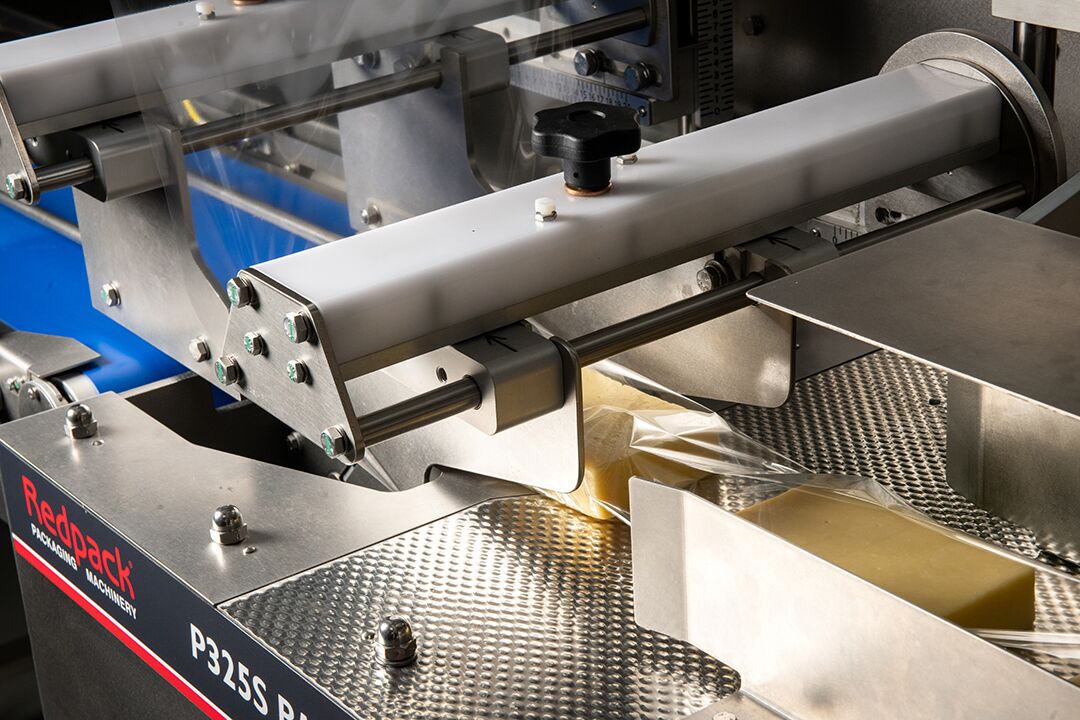Many organisations often wonder what the choices are, how flow wrappers work, what materials are used and, most importantly, how they can benefit their business. This blog post explains all the key considerations of flow wrapping and how it compares against other packaging options, including versus overwrapping.
What can flow wrapping be used for?
Flow wrapping or flow packing, as it is also known, is one of the most frequently found packaging methods across a wide variety of product categories. These are most commonly, fresh produce, meat, fish, dairy, confectionery, bakery items, stationery, medical and personal hygiene products and even computer components. Many of these items have specific packaging requirements such as preservation, contamination, tamper evidence and brand display which flow wrapping caters for.
How does flow wrapping work?
The process of flow wrapping is achieved with a flow packing machine. This machinery carries out a predefined process to produce an end flow wrapped product, as follows:
- Products are placed or moved robotically onto a conveyor.The products on the conveyor are either pushed or carried to the wrapping material.
- The machine automatically feeds the sealing film that has already been printed and labelled online, as necessary.
- The edges are aligned and sealed by applying a combination of pressure and heat or just pressure in the case of cold seal materials.
- The sealed product is moved to a cutter to separate items. This is using either rotary or box motion jaws, determined by the application. Any products that are missing will not have a bag created to save packaging.
- The final product is moved on a conveyor to be secondary packed or just boxed.
A horizontal machine is the most common type used but vertical machines are also available. Generally, it depends on the type of product being packed; vertical machines are used for sweets, some dry goods and salad leaves among other categories.
What are the key benefits of flow wrapping?
Versatility
Flow wrapping of flow packing can be used on a wide range of products from food to medicines, along with household goods, to high value items where security is important like computer hard drives. Some other wrapping methods, like stretch wrap, are constrained by the shape of manufactured items, flow wrapping is not.
Branding
Flow wrap machines make brand integrity cost effective, consistent, and flexible. Pre-printed film and paper, that is recycled and recyclable, are both options. When online printing and processes are built into a single pass, there is a great deal of value that can be added without significant cost.
Labour Efficiency
With the addition of technology to ensure that the number of staff required to run and change a flow wrap machine is minimised, labour can be deployed elsewhere in the process. Additionally, it is now standard that machines are increasingly intuitive with multilingual HMI’s or Human-Machine Interfaces.Couple this with the fact that diagnostics and updates can be added remotely, over-the-air, then a flow wrap machine can be described as truly low cost to run and maintain.
Speed
Flow wrapping is a high speed process which is very efficient for large scale production
The rate of flow wrapping varies significantly based on the machine, packaging type, pack size and additional considerations.
Some of the basic flow wrapping machines generally have working speeds of between 20 to 150 packs per minute. High-end, high-speed flow wrapping machines with speeds of 300 to 1500 packages per minute are usual for packing large quantities of products where time and cost are important.
Airtight Outcomes
Flow wrapping delivers an airtight packaging outcome. With the removal of oxygen, it protects the product from contact with moisture and any form of airborne contamination including dust. Modified Atmosphere Packaging (MAP) or gas flushing is the practice of modifying the atmosphere inside packaging containing perishable foods where oxygen is replaced by nitrogen or carbon dioxide. The aim of the process is to improve the shelf life and freshness.
Machine Integration
Horizontal flow wrapping machines can be seamlessly installed in production lines, enabling inter-equipment communication and linking, for a single point of control. With technology on the rise, the use of robotics and automation to feed and pack flow wrapped products is becoming increasingly cost effective in any application.
What should I budget for a good flow wrapping machine?
The cost of a flow wrap machine can vary greatly depending on what needs to be packed and the material in question. While the low-price tag of some machines may seem very attractive, the cost of ownership needs to be factored in. A flow wrap machine, for example, that requires a high manual labour input or that is unreliable, can suddenly become very expensive. Similarly, if service from the provider is poor and spare parts are unavailable or on long lead times, having a machine standing idle for even a few days can knock the edge off a low initial purchase price. It is wise to factor service and backup into the equation when making the purchase decision.
In all cases the flow wrap machine is usually the most important consideration as typically, there will be no back up flow wrapper, should an issue causing a stoppage occur.













